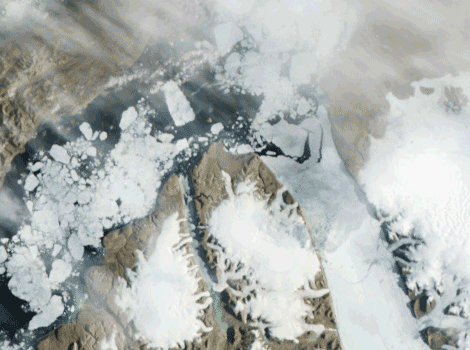This was so extraordinary that at first I questioned the result: was this real or was it due to a data error?
This is not what you want to hear from scientists studying melting ice.

This is an unrelated-but-evocative iceberg breaking off a glacier in Greenland.
This morning, NASA revealed that Greenland’s surface ice is melting over a larger area than they have ever before seen.
For several days this month, Greenland’s surface ice cover melted over a larger area than at any time in more than 30 years of satellite observations. Nearly the entire ice cover of Greenland, from its thin, low-lying coastal edges to its 2-mile-thick center, experienced some degree of melting at its surface, according to measurements from three independent satellites analyzed by NASA and university scientists.
On average in the summer, about half of the surface of Greenland’s ice sheet naturally melts. At high elevations, most of that melt water quickly refreezes in place. Near the coast, some of the melt water is retained by the ice sheet and the rest is lost to the ocean. But this year the extent of ice melting at or near the surface jumped dramatically. According to satellite data, an estimated 97 percent of the ice sheet surface thawed at some point in mid-July.
97 percent. Usually about half of the surface melts; this year, almost all. Hence: “extraordinary.”
This extreme melt event coincided with an unusually strong ridge of warm air, or a heat dome, over Greenland. The ridge was one of a series that has dominated Greenland’s weather since the end of May. “Each successive ridge has been stronger than the previous one,” said Mote. This latest heat dome started to move over Greenland on July 8, and then parked itself over the ice sheet about three days later. By July 16, it had begun to dissipate.
Even the area around Summit Station in central Greenland, which at 2 miles above sea level is near the highest point of the ice sheet, showed signs of melting. Such pronounced melting at Summit and across the ice sheet has not occurred since 1889.
Since melt often re-freezes, it’s not yet clear the extent to which this will impact overall ice volume or sea levels. Remember: If we all just ignore it, the problem will go away.




